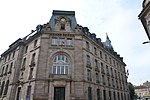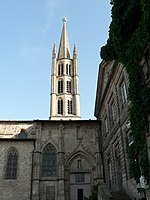Limoges-Bénédictins station
20th-century architecture in FranceArt Deco architecture in FranceBuildings and structures completed in 1929Buildings and structures in LimogesMonuments historiques of Nouvelle-Aquitaine ... and 2 more
Railway stations in France opened in 1856Railway stations in Haute-Vienne

Limoges-Bénédictins (French: Gare de Limoges-Bénédictins) is the main railway station of Limoges. It is situated on the Orléans–Montauban railway. It was named Bénédictins due to the presence of a Benedictine monastery closed during the French Revolution.
Excerpt from the Wikipedia article Limoges-Bénédictins station (License: CC BY-SA 3.0, Authors, Images).Limoges-Bénédictins station
Esplanade Roger Gonthier, Limoges Le Grand-Treuil
Geographical coordinates (GPS) Address Website External links Nearby Places Show on map
Geographical coordinates (GPS)
| Latitude | Longitude |
|---|---|
| N 45.836111111111 ° | E 1.2675 ° |
Address
Limoges-Bénédictins (Gare des Bénédictins)
Esplanade Roger Gonthier
87000 Limoges, Le Grand-Treuil
Nouvelle-Aquitaine, France
Open on Google Maps










